The Bagpipe Society
Early 17th Century Bagpipes in Praetorius’s Syntagma Musicum II

The woodcuts that appear in Michael Praetorius’s Syntagma Musicum II are almost too well known and are so often taken for granted that it’s easy to think we know all there is to know about them. Less well known are the written descriptions and the pitch and range charts of the instruments that are included in Syntagma Musicum. In order to fully understand the information that is being presented, it is necessary to consult and combine all these three areas of information. The errors and misunderstandings that are present can be corrected and what can appear as a tangle of information can be unravelled to reveal a comprehensive picture of the instruments. What might have been completely obvious to a reader in Lower Saxony in the early years of the 17th century can be lost on a modern reader. We are looking back four hundred years to a culture that is distinctly different from today’s; therefore, it helps to understand a little about the background to the publishing of Syntagma Musicum, the making of the woodcuts as well as the author himself.
The early 17th century was on the cusp of late Renaissance and early Baroque music. It was a time of prodigious musical activity throughout Europe, encouraged by technical innovations that had allowed the development of musical instruments to flourish.
Michael Praetorius (1571-1621) was one of the most significant German musicians of his time and spent most of his life in the service of the Duke of Braunschweig-Wolfenbüttel where he was made Kapellmeister at the age of 33. He died in Wolfenbüttel in 1620 and is purportedly buried beneath the organ in the Hauptkirche Beatae Mariae Virginis in Wolfenbüttel. Sadly, his memorial was removed, along with many others, in a 19th century modernisation but the historic town and the church are well worth a visit.
His output was prolific. He composed well over 1000 works, and although most of them were sacred, they included harmonisations of dance pieces as well as arrangements of traditional songs. Although principally an accomplished organist, only eight pieces for organ are known today. As well as being an organ designer and consultant he had an interest in all aspects of music making, including instruments.
Praetorius was born in Creutzberg, now spelt Kreuzberg, and signed his name “Michael Praetorius C” or “MPC”, an abbreviation adopted throughout the rest of this article. The few illustrations we have of him show that he was short in stature with a mass of dark curly hair. He had an acerbic wit that appears from time to time in his writing.
De Organographia
In 1619 MPC published De Organographia. This was the second volume of his encyclopaedic Syntagma Musicum, the first volume being published in 1615. In it he set out to describe, in detail, all the musical instruments that were known to him and in use at the time. It is an incredibly thorough work and gives modern early music musicologists, performers and instrument makers a detailed insight into the musical performance and practice of his time. Syntagma Musicum III was also published in 1619. An intended forth volume was never published as MPC died in 1621. Of particular value to instrument makers is the appendix to De Organographia entitled “Theatrum Instrumentorum or Sciagraphia”. This consisted of 42 woodcuts of musical instruments, each a full page in size and many with a scale in Brunswick feet.
The “Theatrum Instrumentorum” contained instruments of every category, including strings, woodwind, percussion, keyboard and brass. It also encompassed instruments that MPC had not personally seen but were shown in Sebastian Virdung’s Musica Getutscht of 1511 as well as others probably described to him by fellow musicians. Being a comprehensive publication, it included six different types of bagpipes that were known to him at the time.
Theatrum Instrumentorum
The highly detailed introduction page reads:
“Theatre of Instruments or Sciagraphia. Michael Praetorious. Consisting of exact drawings and Facsimiles of almost all the musical instruments currently in use and available in France, England, Germany and other places. Also, various ancient and ethnic instruments and instruments from the Indies, all accurately and faithfully drawn to scale and categorised. Wolfenbüttel in the year 1620.”

On the first page is shown, in full size, six inches of the scale used in the woodcuts and under this he states:
“This is the correct length and measure in units of half a shoe or half a foot, after the standard of one-quarter of a Brunschweig ell. All the drawings of the following instruments are made in accordance with this measure, which accompanies each drawing in scale.”
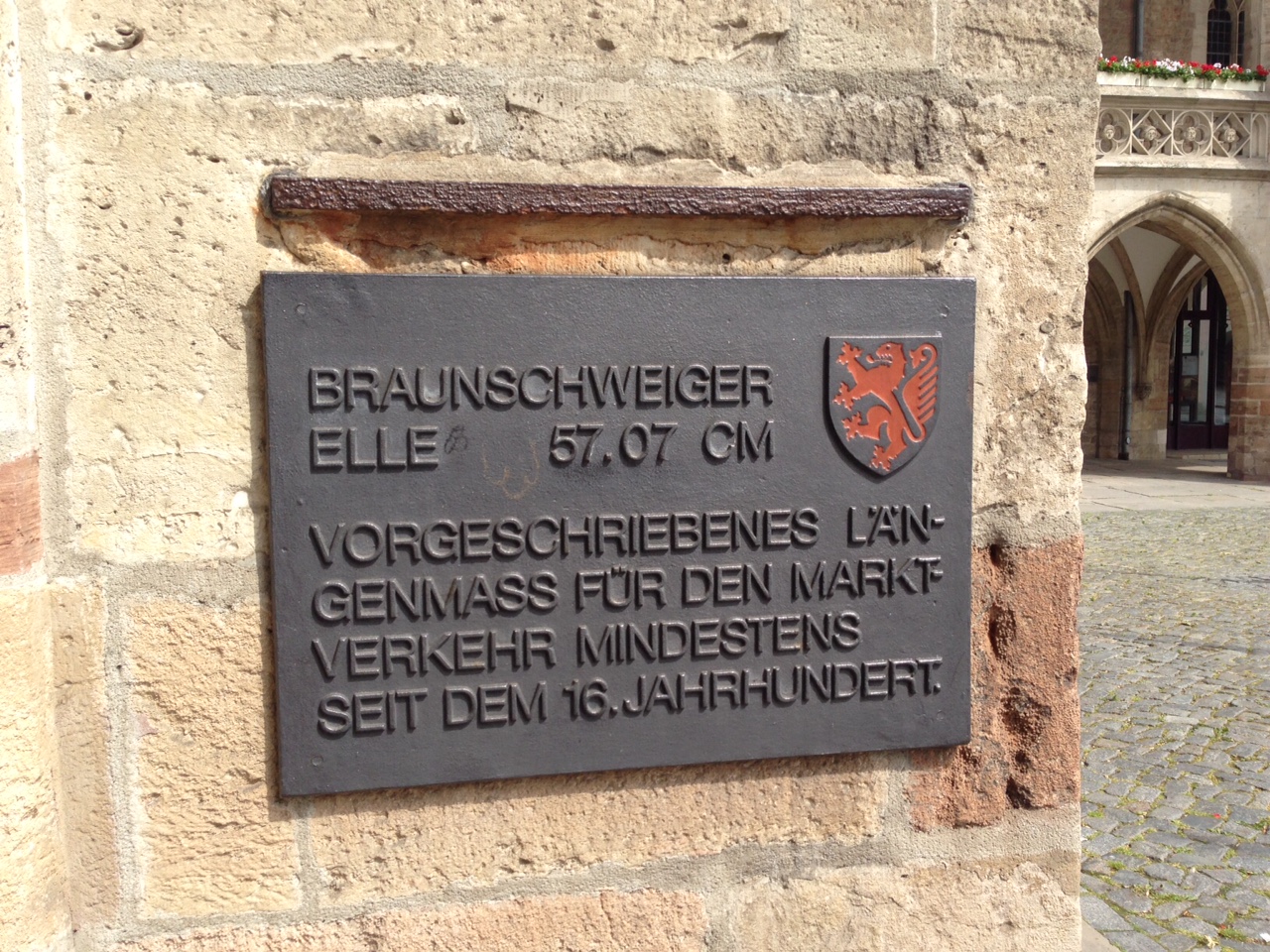
If you ever visit the historic town of Brunswick in Lower Saxony find the old Rathaus (Town Hall) situated in the town square. On the right-hand side of the building, you can see the original Elle. Unfortunately, its detailed markings have been eroded through weathering over time. However, we know that one Brunswick foot is equal to 11.22 modern inches or 285 mm. Knowing the exact size of the scale MPC uses in the woodcuts makes it straightforward to scale the instrument to modern measurements with a fair degree of accuracy.
As well as producing the woodcuts, MPC also wrote a comprehensive description for each instrument that included information on how they were played, the most useful sizes, their ranges, and any recent developments of which he was aware. He also produced a “Tabella Universalis” that showed the pitch and range of each instrument including any falsetto notes outside of their normal range.
Linking together the scaled woodcuts, the information in the Tabella and his written descriptions creates a comprehensive picture of any instrument.
The Woodcuts
Of the 42 woodcuts, just over half are given a scale. Those that do not have a scale attached tend to be drawings of large organ cases, details of instruments etc. where a scale is not necessary, or ethnic instruments that perhaps MPC had not seen himself. Those with scales are precisely laid out and it is obvious that careful consideration was given to the placement of instruments to show as much detail as possible. It’s clearly the case that whoever MPC contracted to produce the wood cuts, and there might well have been more than one artist, must have had access to the instruments and handled them in order to obtain accurate measurements.
It is more than possible that many of the contemporary instruments we see in the woodcuts were bought to Kassel from Venice by Schutz the composer for the Landgraf* Moritz of Hessen-Kassel; although they were probably the more experimental instruments such as the Bassanelli and Schryari and not the other mainstream instruments that MPC depicts. MPC visited Kassel in 1605, 1609 and 1617 and it would appear that he gained information about the instruments in the possession of the Landgraf* Moritz of Hessen-Kassel and his musicians and used it in his Syntagma Musicum II.
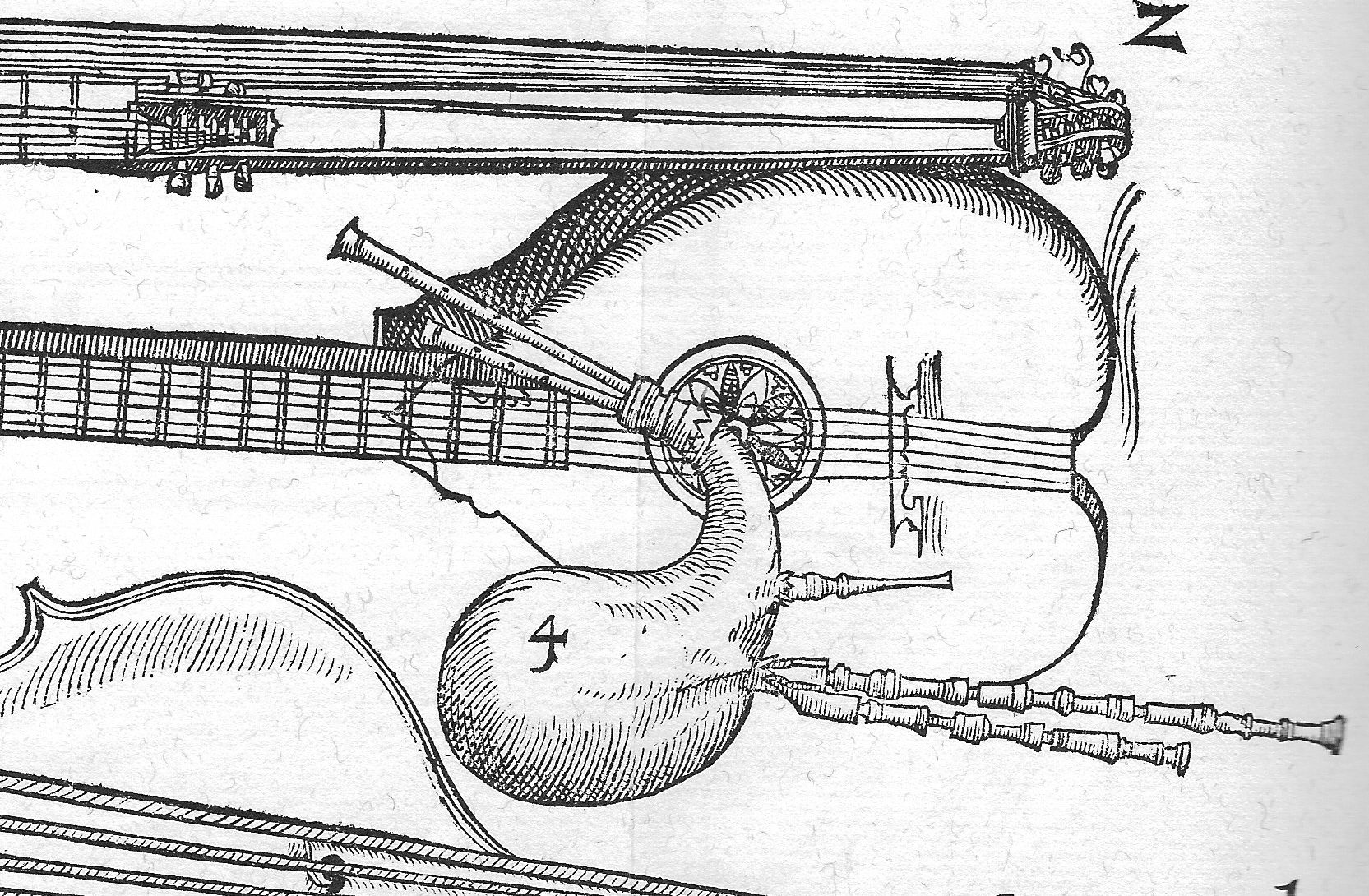
These accurate woodcuts, meticulously drawn to scale, are probably some of the earliest scale drawings to come down to us and must therefore be regarded as trustworthy. There is obviously not enough detail depicted to make accurate copies of the wind instruments as bores and internal details have not been shown, but the woodcuts still contain a wealth of information that is reliable, and they are a very useful resource for research purposes. As a maker and researcher of historical woodwind instruments I have found MPCs work to be of immense value and my facsimile copy of Syntagma Musicum II is very well thumbed. However, as in any encyclopaedic work of this size there are the occasional obvious errors, but still, I put great trust in the accuracy of these woodcuts. They are not just rough sketches but accurate scale drawings, the equivalent of early 17th century photographs of known instruments. The Bagpipes appear in plates V, XI and XIII.
* A type of Count
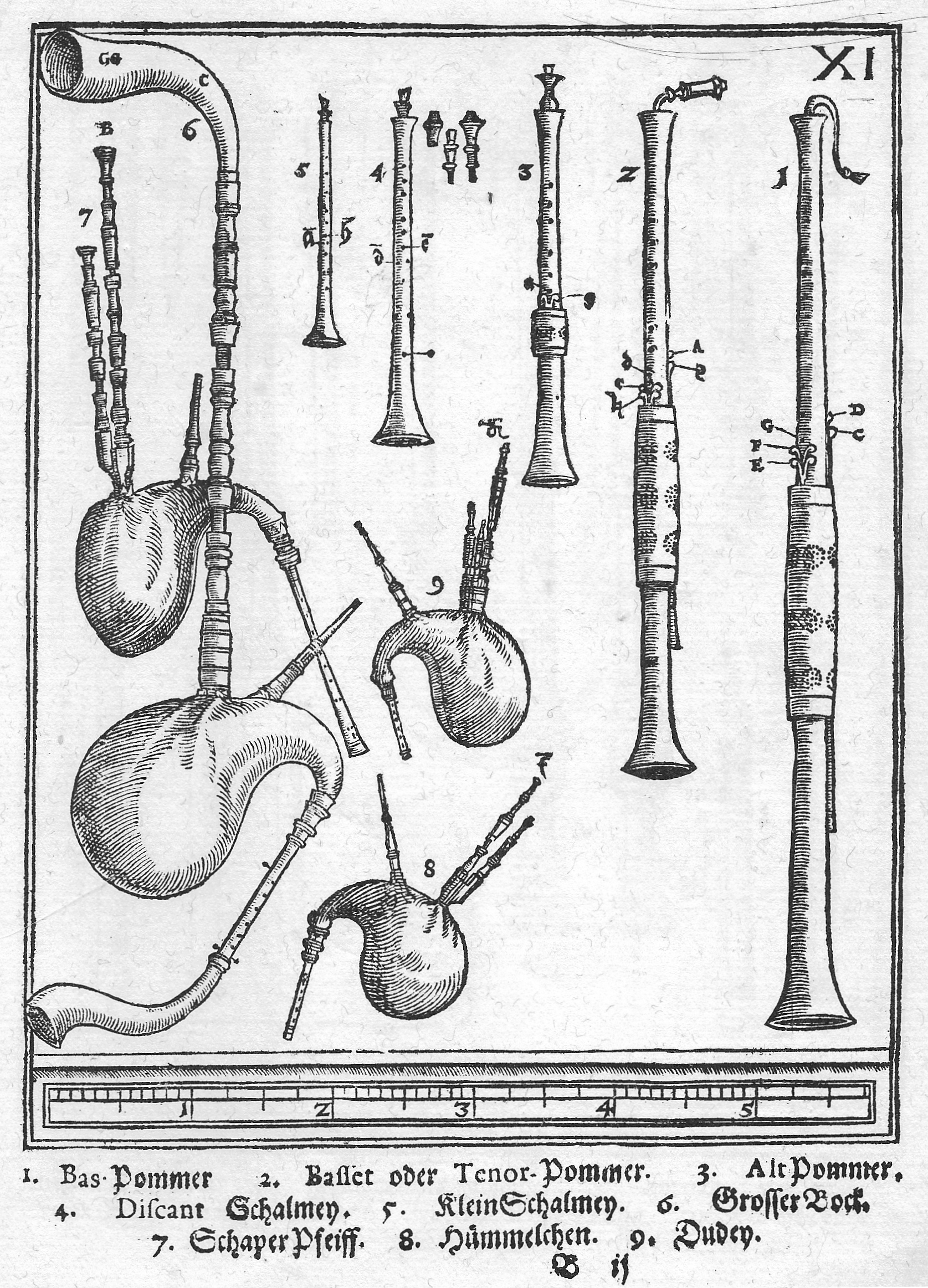
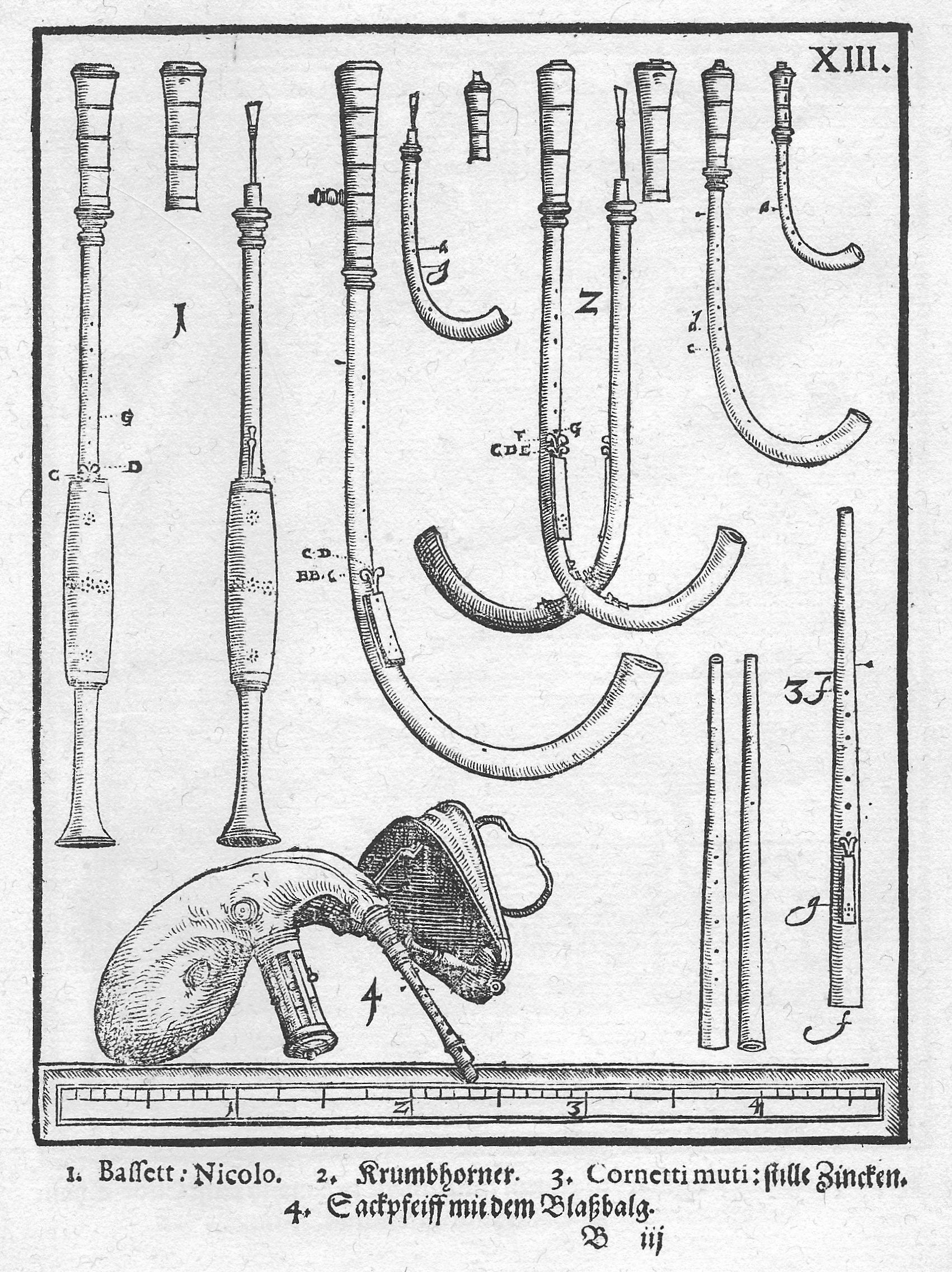
The Bagpipes
The following scaled measurements, taken from the woodcuts, given in this section are in modern inches and millimetres. Chanter lengths are from the approximate reed tip position to hole six, or all front holes closed without the little finger. This is the most reliable measurement for comparison with modern instruments for establishing an approximate pitch. They are necessarily approximate as it is impossible to know exactly where the reed tips are in the stocks.
I have tried to copy the spellings that are given in the original text for the names of the pipes but typically for this period they are remarkably inconsistent. For translations of the text, I have relied heavily on the 1980 translation of Syntagma Musicum by Harold Blumenfeld. It is reasonably accurate, but I am sure an up-to-date translation would be well received by the Early Music fraternity. Some sections have been translated by Tony Millyard and my scant understanding of German has been thoroughly tested.
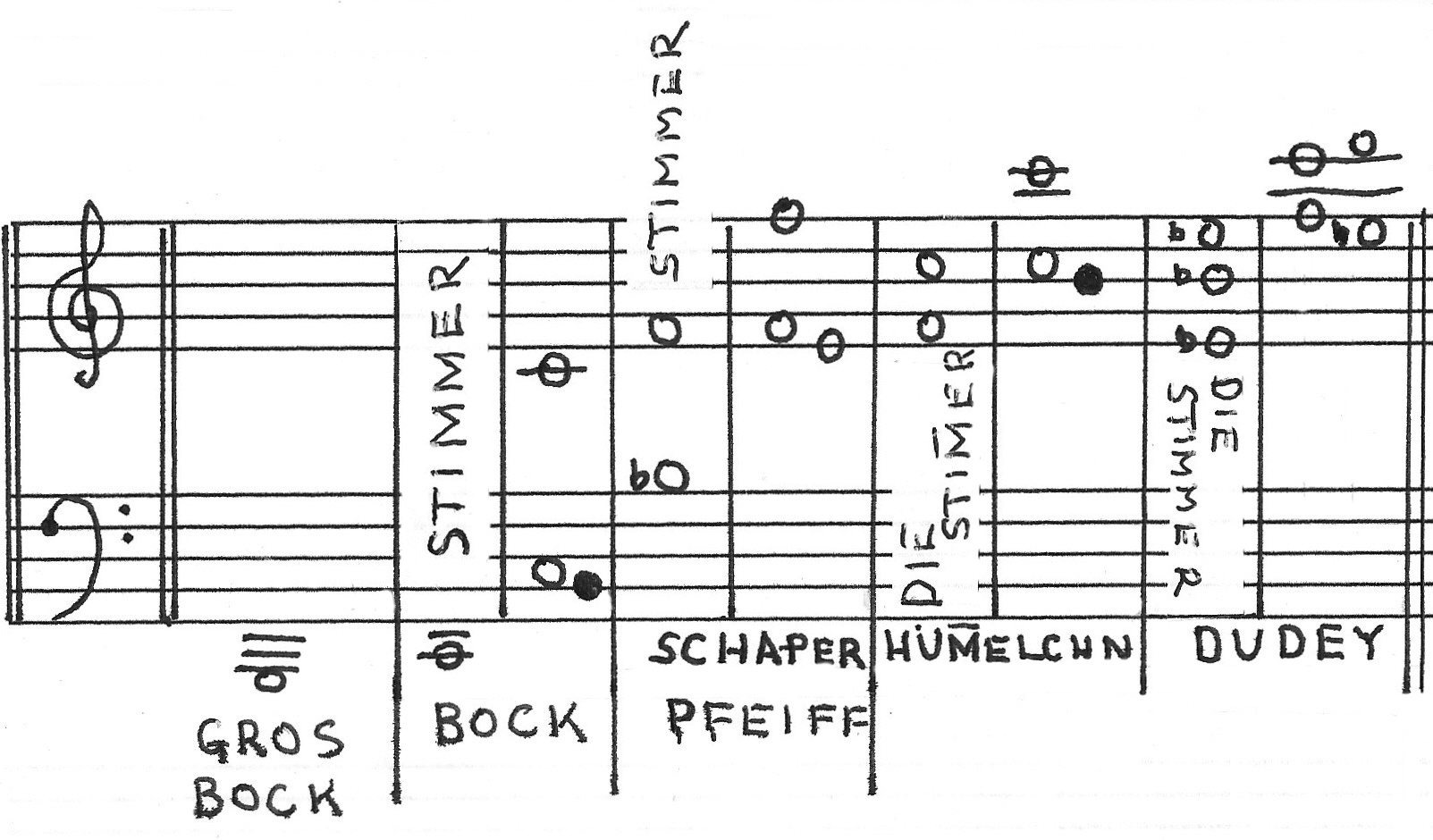
Pitches are designated as follows. C is the c below the bass stave, then D, E, F, etc. until c (second space on the bass stave), d e f etc. until c’ (middle c) d’ e’ f’ etc. until c” (third space treble stave) d” e” f” etc. until c”’(c above the treble stave) and so on.
In the section on wind instruments MPC writes about six different types of bagpipes: the Bock, Schaperpfeiff, Hummelchen, Dudey, Magdeburg and Musette (unnamed)
It is obvious that he is not as familiar with bagpipes as he is with other wind instruments as his descriptions are relatively brief and are placed last in the section on wind instruments.
His brief introduction states.
“Of Sackpfeiffen (Latinis,TibiaVtricularis. Italis CornaMusa) there are many kinds.” “1. Bock, which has just one great long horn (drone) tuned to the deep C. Some are a fourth deeper, on GG, and are rightly called Grosse Bock. (Large Bock)”
The name Bock [Billy-Goat or Buck] could refer to the skin of the bag but more probably the goat like braying sound the pipes make. An Eastern European instrument, Bocks of many different forms, with single reeds, are still played today in many Eastern European countries, many with large cow horns or similar. The horns are certainly not from goats!
Chanter length 11.4“, 320 mm. Drone length (very approximate indeed!) 48.6”, 1231 mm. The woodcut shows hole seven twinned (the dots on stalks) and a thumb hole. The drone has a GG shown at the very end of the horn bell but a C further inwards. This does not indicate that the one bagpipe could be tuned to both pitches but rather shows that the larger instruments drone is in GG; its chanter therefore being in G. Traditionally single reeds were used in both the chanter and drone.
The pitch chart gives the chanter range as c to c’ with a leading note of b. A flat sign is not given but knowing MPC’s inconsistencies in these matters it could possibly be b flat as flattened leading notes sit well with folk and traditional music. The drone is given as C, an octave below the key notes, and in a separate column entitled Gros bock (Large Bock) there is a GG. The range is not given for the large Bock but the assumption is that it’s also an octave, but from G. If this were correct it would be a very, very large instrument indeed.
In the woodcut, the instrument is labelled “Grosser Bock” and, comparing it with the sounding lengths of other cylindrically bored instruments, such as crumhorns, the length of the chanter would indicate it being an octave higher than is shown in the pitch charts. The range of the Gross Bock is missing from the chart, maybe indicating MPC’s confusion or lack of information regarding the bagpipes and their octaves.
The solution is: Gross Bock chanter g to g’, leading note f, drone G. Small Bock chanter c’ (middle c) to c’’, leading note b, drone c.
In his pitch charts, MPC tends to give the pitch of wind instruments on the six finger note and then a separate note to one side for the leading note. Blacked in in this case.
Based on a comparison of the sounding lengths of other cylindrically bored instruments, such as crumhorns, the pitch of the instrument is nearer to the bass clef c that MPC gives rather than an octave higher as has been suggested in other past articles.
“2. Schaperpfeiff; has two drones, b flat and f’. Schafferpfeiffern (Shepherdpipes) are usually out of tune in the upper holes. I believe this is because they have no thumb holes at the back. But other bagpipes, such as the Bock, Hummelchen and Dudy, have a hole in the back such that their tuning may better be regulated.”
Chanter length 11.3 “, 296 mm. Large drone 25.2”, 642 mm. Short drone 15.8”, 403 mm.
By comparison with modern pipes these lengths give a pitch probably slightly higher than our modern pitch.
The woodcut shows six equally spaced finger holes in a line with a twinned seventh hole as is usual on renaissance woodwinds. There are maybe two, possibly three, tuning holes close to the bell. The conical chanter would have been double reeded with the drones single reeded.
The pitch chart clearly shows the instrument to be in f’, six finger note, with a range of an octave above that, and a leading note of e’. The drones are in f’, unison with the six finger note, and b flat, a fifth below. The tonality generated by the lower drone and its fifth would be B flat.
Because there is not a thumb hole the top note, f” can only be obtained by over-blowing the lower f’, with the top hole acting as a speaker hole. In order for that to be possible, this top hole has to be in approximately the same position as the thumb hole on a standard chanter, thus increasing the stretch of the upper hand’s fingers. Hole one, the top hole, now being in the same location as a thumb hole, hole two also has to be moved up, otherwise the stretch between holes one and two is impossible. The woodcut clearly shows this to be the case with all the finger holes being unusually equally spaced. Thus, these upper holes sharpen the scale until the overblown f”. It’s interesting that MPC states that they are out of tune in the upper holes not the upper notes possibly, indicating that the octave f’s are in tune.* An instrument with these features survives in the Hofburg Museum in Vienna and replicas of this instrument have shown that it plays a sharp fourth exactly as MPC describes.
* Thanks to Michael Vereno for pointing out this arrangement and the instrument in Vienna. His article in Chanter Summer 2016 is well worth reading.
“3. Hümmelchen; that also has only two drones f’ and c’”.
Chanter length 6.5”, 178 mm. Larger drone 9.3”, 250mm. Small drone 6.9”, 190 mm.
According to the pitch chart the chanter is pitched c” with a range of an octave to c”’, and a leading note of b’ or possibly b’ flat. The drones are in c” and f’ the larger drone an octave below the three finger note. Probably a double reed in the chanter with single reeds in the drones.
“4. Dudey / has three drones tuned e’flat, b’flat and e’’flat.”
Chanter length 4.6”, 118mm. Larger drone 11.3“, 297mm. Middle drone 6.5”, 297mm. Small drone 5.6”, 142mm. Again, probably a double reed in the chanter with single reeds in the drones.
Probably because of MPCs lack of familiarity with the Hümmelchen and Dudey he gives their pitches as an octave higher than they would have sounded. The size of the instruments in the woodcuts indicate the Hümmelchen would have played in c’ with drones in f and c’ and the Dudey in e’ flat with the drones in e flat, b flat and e’ flat.
Magdeburg Pipes
MPC does not give a number or title for the next two pipes but continues without a break.
“In the Archbishopric of Magdeburg I have seen a special type of Bagpipe which is a little bigger than the Schaffepfeiffen pipes and is a third deeper. It has two drones and below two chanters one for the left, the other for the right hand. On each chanter there are three holes in front and one behind for the thumb so that with the left hand g a’ h’ c’ d’ and with right hand d’ e’ f’ g’ a’ can be played. And so a duo or Bicinium can be played on it very easily. A drawing of it can be found on plate V.”
Chanters 12.1”, 285mm. and 6.9”, 190mm. Drones 22.44“, 380mm, and 14.7”, 380mm. The woodcut shows the upper chanter for the right-hand chanter and the lower for the left; the reverse to normal but the same as is found on the Zampogna.
The pitch of the drones is not given but from their approximate lengths they would play in d’ and g’. Some of the notes that MPCs gives in the left hand a’ h’ are an octave too high and make no sense. Corrected the left hand should read g a h c’ d’. So now we have – Right hand d ’e’ f’ g’ a’ playing the melody. The left-hand g a h c’ d’ playing the harmony, and the drones on d’ and g’ supporting the right hand. The instrument is pitched in d’, exactly as MPC says, a third deeper than the Schaperpfeiffen.
Musette: “In France a little bagpipe or Hümmelchen (Plate VIII) has been constructed into which air is pumped by means of a small bellows operated by one arm.”
Also, a person mentioned earlier in 5 has considered these matters and has made completely different voices (pitches?) from five such bagpipes that are governed by bellows. Then you can play a piece with four or five voices if you will. But such harmony I am not finding very pleasing.”
The Musette may have been relatively new to MPC as he does not call it as such but describes it as a “Sackpfeiff with bellows”. Fully formed, it’s very likely the first-known picture of this instrument and it is significant that it came from France.
The chanter length is 8.4”, 214mm. and has seven finger holes in the front and a thumb hole is indicated in the usual way with a dot on a stem, there also looks to be a small top key. The shuttle drone shows four sliders and is 3.5”, 95mm. long. The bellows show what could be a single pleat. An almost identical instrument dated from the second half of the 16th century is preserved in the Chateau d’Ambras. The single chanter has the bell missing and there are four shuttles in the drone.
Conclusion
I hope that in bringing together all the information about the six bagpipes Michael Praetorius included in his Syntagma Musicum has provided a better understanding of these instruments. It’s obvious that the instrument makers of the period were highly skilled and, as an instrument maker myself, I am continually amazed at their knowledge and ability. I look forward to seeing copies of these instruments in the future.
- Data Processing Notice (GDPR)
-
@BagpipeSociety on X (formally known as Twitter)
-
TheBagpipeSociety on Instagram
-
 BagpipeSociety on Facebook
BagpipeSociety on Facebook
Something wrong or missing from this page? Let us know!
